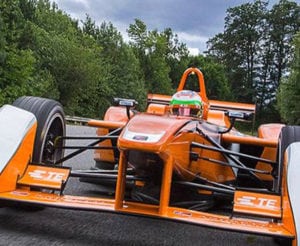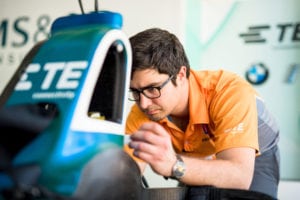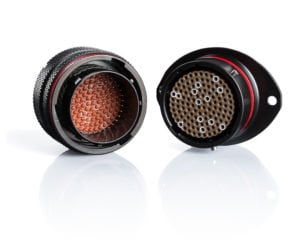Formula E Takes a Victory Lap
TE Connectivity looks back on a season of innovation and excitement in all-electric auto racing.

Season 4 of the world’s premier electric auto racing championship series is over, but Season 5 — and an all-new car — is just around the bend. On Sunday, the TECHEETAH team and driver Jean-Éric Vergne took the championship in a nail-biting tour of New York City in the rain. This marks the last race for the familiar Spark-designed Formula E machine. The next season of Formula E racing will debut the Gen-2 car, which features a Halo cockpit and styling as future-cool as the technology that powers it. Connector companies and distributors including TE Connectivity, TTI, Molex, LEMO, Würth Elektronik, and Mouser have played an important role in the development of this sport. We talked to TE engineer Paul Webb about the season and what the connector world is working on for the next one.
What role does TE Connectivity play in the Formula E world, and what role does Formula E play in TE’s company and culture?
TE Connectivity plays in integral role in all professional motorsport, but our close links to Formula E come from being part of the original design team for the Season 1 car and thus being part of the DNA of the series from the beginning. Formula E will be looked back on as being ahead of its time. I remember a fair degree of skepticism that the first season would even happen, and that this newfangled electric formula would not capture the imagination of an audience who had grown up on gasoline powered racing. However, what actually happened was it appealed to a whole new audience to whom F1, NASCAR, Indycar etc., had become dull and something that didn’t engage them. It struck a chord with TE too. We’d been in the racing business for many years, but this was the first time the TE brand had actually appeared on the side of a car. It immediately created a stir as our staff wanted to know more. When they saw the cars in action at the track and all the technology involved in making a racing car function, it proved to be far more than just a sticker on the side of a car. It was more of an engineering experience to everyone.
You have a long history working on both Formula 1 and Formula E. From a components point of view, do you have a preference, and why?

Paul Webb
I like both! Both offer unique technical and logistical challenges, and both are pushing what is possible with technology today. F1’s rate of development is still astonishing — and this is my 18th year of being involved in racing — because the car you see at the start of the year changes hugely under the skin as the season progresses. This is obviously a big challenge for us to keep up with, as they are not able to forecast their R&D or accident damage requirements to us and they change the designs as the season goes on. Formula E, however, has to homologate their designs before the season starts and only allows refinement to software and car setup. However, they are really pushing what is possible with battery, inverter, and motor technology. And, like all race teams, they will push all the components on the car to the limit, as efficiency is what wins the day and any excess weight is a penalty to success when things like the chassis, battery, and aero are essentially the same across the grid.
What new innovations, in terms of regulations, product developments, or other, influenced this year’s vehicles?
Season 4 wasn’t a huge leap from Season 3. This is mainly because the cars come to the end of their working lives this year and a lot of effort is being put into the brand new Gen-2 car for Season 5. However, motorsport isn’t generally about huge leaps forward now and more about incremental gains from small refinements all over the car. Formula E is not different to any other race series where weight optimization (balance), brake by wire setup, and aero dictate how the car performs round the track. But the key to success is energy efficiency and how you manage the power from the battery in terms of heat, regeneration and deployment through the race. If you can maintain a decent pace and employ “lift and coast” to optimize energy use early in the race, you then bank the opportunity to go for it later on in the race if your competitors are running low on power themselves. It’s a new mindset for the drivers and engineers to work with.
Were there any surprises this year?
Not really. The dominance of some teams that had been strong performers in the past was not really there at the start of the year, as they struggled with reliability issues. But, as the season progressed, the order returned to a more expected level. It goes to show how close everything in Formula E is. A small slip in engineering, reliability, setup, or driving can make the team go from hero to zero or the other way around quite quickly. Some cars were amazing on certain tracks and nowhere on others, which points to setup or maybe design that focused on a specific element. Overall it has been nice and unpredictable, which is how racing should be.
Many electronics companies are involved in Formula E. What did you see coming from other groups that impressed you?

TE Connectivity’s resident engineer with Andretti Technologies, Maurizio Mercurio, works on the TE Connectivity Andretti Technologies Formula E Test Car.
Because our parts are used by every team for the critical data systems — regardless of the stickers on the side of the cars — other component suppliers have found areas in the powertrain where they have had involvement with the teams. The inverter and motor are completely down to each team to optimize, and they can either buy a solution or engineer something themselves. Optimizing the motor and inverter has been a decent learning curve. It’s been interesting to see companies who were involved at the start with more off the peg solutions being changed vs. companies that have had to develop solutions specifically for Formula E. I think the tech used in the inverter has been the most interesting area and the most highly guarded in terms of secrecy, too. As a result, I’m not able to share what the grid has been doing for everyone because I’m not privy to all their solutions.
This is the last season we’ll see the Spark-Renault SRT chassis. What can you tell us about the new car for the 2018-19 season?
The Gen-2 car is quite a step forward in looks and technology. Formula E has kept with the idea of an efficiency formula so, although the aero looks pretty crazy, actually it’s the underside of the car that generates the downforce through venturis in the floor and a huge rear diffuser. The big change will be for the car to run the whole race distance. At the moment we have the exciting and unique car change halfway through the race because the old battery tech wasn’t able to run at race speed for the whole race distance. When the car was initially designed, the technology didn’t actually exist to run the full race, so it’s been really interesting to watch as McLaren Applied Technologies produced a racing battery capable of the job. I really like the use of LEDs in the driver’s head protection and the shrouds round the wheels to improve aero and safety. I think the designers have really got it right visually and the teams are getting on top of the new tech in the powertrain too. What’s amazing is how much has changed in five years, though. Racing is a really amazing way of moving technology along.
What innovations do you see in e-autosports that have the potential to come to the consumer or commercial automotive sphere?
Electrical technology for the road will be on us before we know it because of environmental and legislative forces around the world. Formula E, EGT, MotoE, E-Rally Cross, WRC-E, and hybrid tech in Formula 1 and LMP1 has moved the goal posts in terms of technology and public acceptance that electric power can be as innovative and exciting as 100 years of the internal combustion engine. Racing brings R&D along at a pace not possible outside competition. Light weight, thermal efficiency, and energy storage has moved incredibly from just five years ago and these innovations will be sitting outside people’s houses in the early 2020s. This is a huge change, but racing has been the key to unlocking the possibilities.
Now that the last race is over, how are the engineers at TE Connectivity feeling?

TE’s DEUTSCH AS Double Density (ASDD) Series connector is a lightweight connector with almost double the number of contacts compared with the regular autosport range equivalent shell size.
Every race teaches us new things. Next year, the new cars will demonstrate this when one car is used for the entire race. [In previous seasons, two cars were needed to run the course due to battery limitations.] The battery in the new car has been developed just in the last 18 months. The technology to deliver that capacity didn’t even exist when the change was announced. The engineers just stepped up and delivered. Next year, each of the 11 teams will have their own motor and powertrain solutions. Some things, like the aerodynamics, battery, and tires, will be spec — they didn’t allow people to go mad and develop something fully from scratch. But there will be a lot of variables and secrets that will make the season very exciting.
What has it been like for the employees at TE Connectivity for the company to be involved in these races?
The astonishment and joy it brings to our people is incredible. The car will come back for a visit so our people can see it. I get emails all the time from people in the company asking about it. The impact of knowing that TE Connectivity is such a major force in auto racing is amazing. It shines a light on a less-known part of our whole enterprise because it’s so cool.
Interested in a specific market? Click a market below for current articles and news.
Automotive, Consumer, Industrial, Medical, Mil/Aero, Datacom/Telecom, and Transportation
- State of the Industry: 2022-2023 Connector Sales - April 16, 2024
- Amphenol is On a Roll - April 2, 2024
- Nicomatic Proves That Two Heads are Better Than One - March 26, 2024












